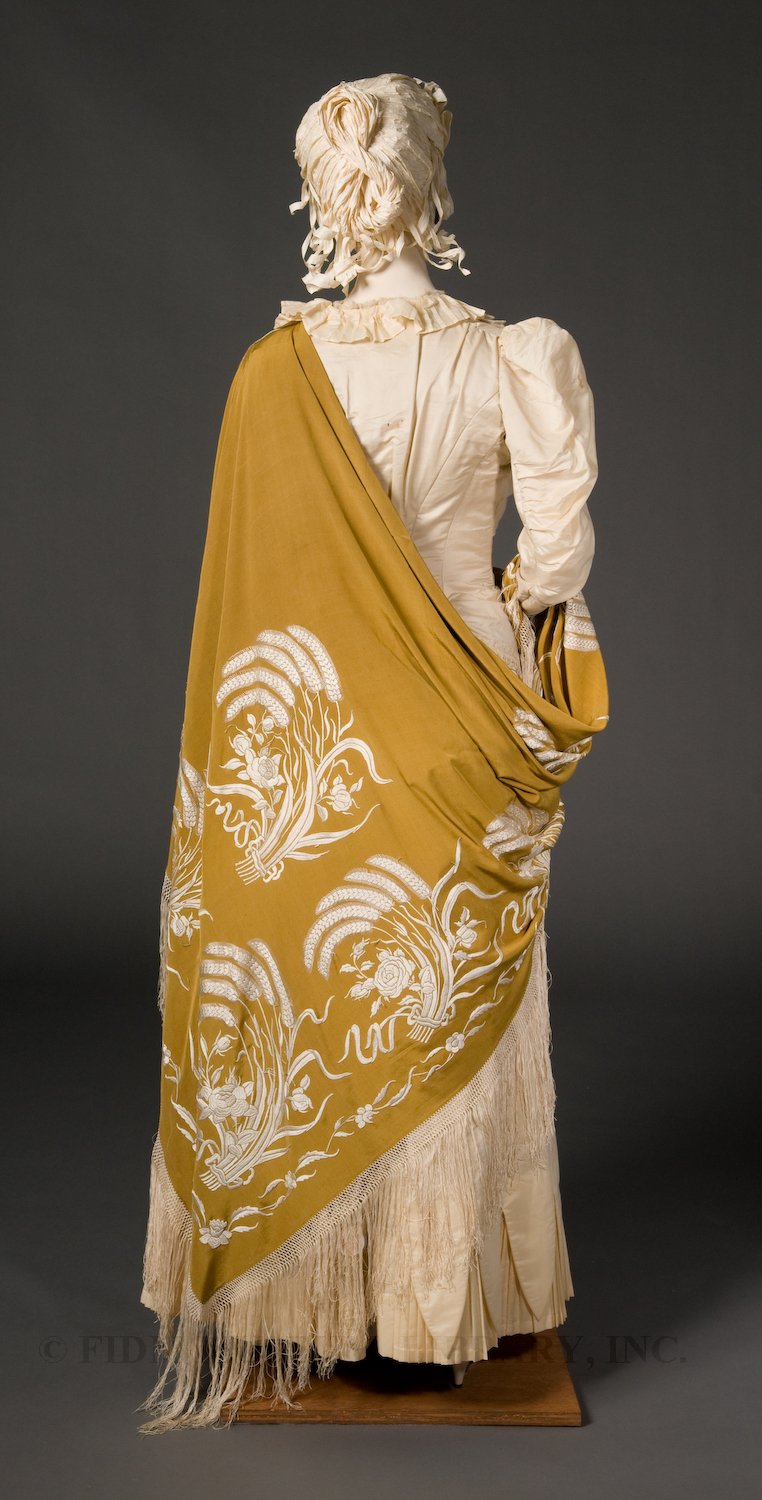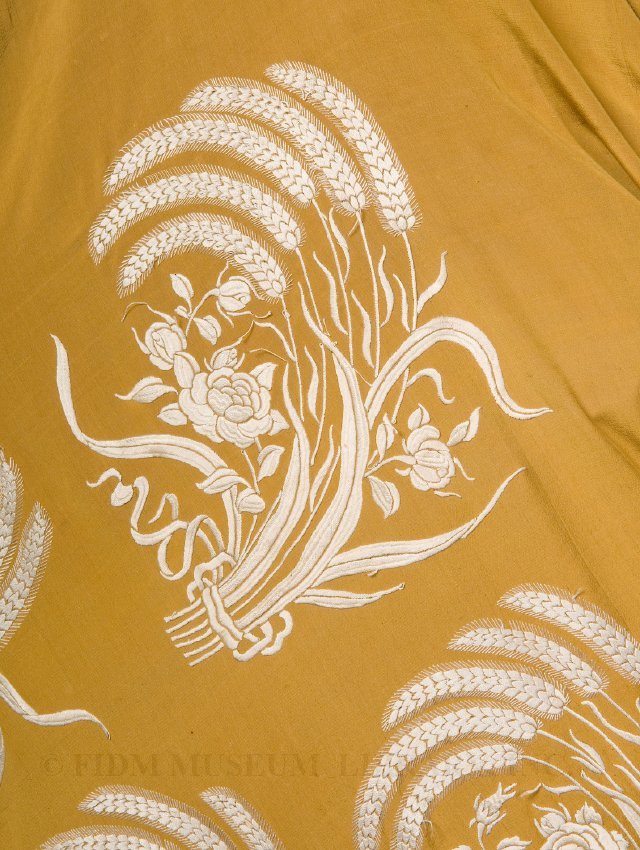Widespread cultural preoccupations or anxieties are often expressed through dress. This can be extremely overt, as in the case of a T-shirt slogan, or much more discreet, as in a frequently recurring decorative motif. In the 19th century, anxiety relating to the Industrial Revolution and the move from an agrarian to urban/industrial society resulted in the frequent appearance of ripe wheat stalks on dress and accessories.
1875-1885
Gift of E. Heise
97.347.1
Often called the staff of life, wheat is a long-standing symbol of fertility, bounty and resurrection. This symbolic association dates to the earliest days of Western civilization, when the cultivation of wheat and other grains facilitated the eventual development of cities and towns. Women were closely associated with wheat, due to a shared ability to perpetuate society: wheat nourished women, who reproduced and then used wheat (in the form of bread) to feed their families.
97.347.1 Detail of wheat and rose embroidery
During the Industrial Revolution, urban living became the norm, with many moving from farm to factory in search of better work. This shift resulted in a idealization of country living and all things associated with nature. In a conscious attempt to reject an increasingly mechanized and standardized way of living, many turned to historic or invented styles of dress and traditional design techniques, such as smocking. These considered attempts to shun certain aspects of an industrial lifestyle were accompanied by more subtle resistance, such as the widespread appearance of wheat patterned and embellished textiles.
 Embroidery detail of polonaise bodice (Read more about this bodice here)
Embroidery detail of polonaise bodice (Read more about this bodice here)
1869-74
Gift of Anne Stampfer
94.661.2A-C
Though textile histories document the widespread presence of wheat patterned textiles, the FIDM Museum only has examples of garments embellished with wheat embroidery. Though machine embroidery was widespread, many women embroidered garments or decorative items for the home. Based on embroidery patterns from the 1860s-1880s, wheat stalks appeared not only on clothing, but also on pin-cushions, footstools, slippers and bed coverlets. Wheat or straw was sometimes used as the actual embroidery medium. We have several fascinating objects with straw embroidery, so you can look forward to seeing these on our blog at some point in the future!
Unlike more conscious attempts to retain links with rural life, the widespread decorative use of wheat seems to have gone largely unexamined. This suggests that it was an unconscious demonstration of longing or anxiety. What cultural preoccupations are currently being displayed through dress? I’ve been thinking about some of the longer hemlines seen on the runways recently. Does this reinforce the old saying that hemlines drop in times of economic uncertainty?




Seems to me that when the current recession began, designers pulled back on the bling factor as a response to the times, showing more somber colors and less luxurious fabrics. It just didn’t seem like the thing to do to show expensive silks and furs when, even in the fashion industry, people were losing their jobs.
Doesn’t seem to me that it was a hemline thing. But I’m not an expert, just a fan.
It is interesting to see that, even in the past, the times were reflected in something as subtle as the presence of the wheat design. A delicate response. But who knows. At that time, something like that might have been equivalent to a billboard. No?
You raise an interesting point about if/how the wheat symbol would have been understood during the height of its popularity. I searched in Victorian flower dictionaries (books that list the meaning of individual flowers) for descriptions of wheat or grain, but didn’t find much information. I plan to keep my eye out for more information!
The hemline question is always tossed around in times of dramatic economic change. During the “roaring” 1920s, hemlines were shorter, though there are exceptions. Hemlines dropped a bit during the 1930s. Of course, there are always examples which prove the opposite of any statement!
Interesting post. I thing that if this practice were to come back into vogue it would have to be corn symbols here in the US. I seem like everything from food to our cars is based on corn.
Interesting post and interesting question in the end.
It is true that during the Great Depression, women’s skirts went all the way to the ground back then.
The post says that “widespread cultural preoccupations or anxieties are often expressed through dress,” so what does that mean with our fascination with animal slippers? Not that designers often introduce lines laden with animal slippers or kids slippers like those that we have at SuperSmartyPants, but adults and kids alike are fascinated with them; maybe it just speaks to our fascination with animals and relaxing.
http://www.supersmartypants.com/kids-slippers.html